Ka-50/Ka-52: forty years old, normal flight!
Forty years ago, on June 17, 1982, as time has shown, a milestone event happened: for the first time, a B-80 project helicopter took off from the ground, which became the prototype for the Ka-50 and Ka-52 family of helicopters.
Stories the path of these machines and is dedicated to this material.
It all started in 1973, when Soviet intelligence reported that in 1972 competitive work began in the United States to create new attack helicopters. Looking ahead, I will say that it is the winner of this competition, the YAH-64 model from Hughes, that we today know as Apache.
At that time, the Mi-24 was the main combat helicopter of the Soviet army, but everything was not so smooth with it. Yes, the "Crocodile" regularly carried out its service, but the desire to have a rotary-wing "both a reader and a reaper", an attack helicopter with a place to detach paratroopers, was paid for by a decrease in combat effectiveness.
And therefore, in response to American developments, a decision was made by the Council of Ministers of the USSR to create a new generation combat helicopter, which could become a worthy response to overseas imperialists.
On December 16, 1976, the Central Committee of the CPSU and the Council of Ministers of the USSR, within the framework of the adopted resolution, obliged the design bureaus of N.I. Kamov and M.L. Mile to create competitive designs for an attack helicopter, the best of which will be put into service. The main task of the new machine was the destruction of enemy armored vehicles on the battlefield and in the near front line. No landings.
Design Bureau Kamov at that time, although it was considered "naval”, but there was experience in creating land models. Shortly before the events mentioned, a land version of the Ka-25F was created on the basis of the ship's Ka-25. This helicopter was supposed to be equipped with a 23-mm mobile gun, six Phalanx ATGMs, six NAR units and aerial bombs. The crew of the Ka-25F consisted of two people, and the cargo compartment could accommodate eight paratroopers.
The project was put up for competition, but then the more modern Mi-24 won, which had the best performance characteristics due to new engines and newer weapons systems such as the Shturm ATGM.
Work on the new machine was headed by the head of the design bureau - chief (later General) designer Sergei Mikheev.
It is clear that in terms of appearance, a choice was made in the direction of the proprietary coaxial screw arrangement. This was justified, since the efficiency of the carrier system of a coaxial helicopter is on average 16-22% higher than that of a single-rotor helicopter. The coaxial rotor helicopter had an altitude advantage of up to 1000 meters with the same engine power, and the rate of climb was 4-5 m / s higher.
In general, a coaxial helicopter has more advantages in terms of control, it can perform maneuvers that are simply inaccessible to a helicopter of a classical propeller arrangement. Yes, this is paid for by a very massive and bulky carrier system, but, as practice shows, it's worth it.
Mikheev decided to make the B-80 single-seat. The absence of a navigator-operator was supposed to be compensated by the electronics of the sighting and navigation system.
Yes, the devil is here. In general, the Ka-25 and Ka-27 already used electronic systems for automatic search for submarines, which actually unloaded the crew. Mikheev relied specifically on electronics, since it was the absence of a second crew member that made it possible to equip the helicopter with all the necessary systems, since Soviet electronics of that time differed in weight and size not for the better.
In addition, there was already considerable experience in the use of single-seat attack aircraft, which operated on the battlefield in much the same way as helicopters were supposed to be used. This is how the A-4 Skyhawk worked in Vietnam.
One pilot on board and the coaxial scheme caused many objections to the Kamov Design Bureau project, but in the end, Mikheev (more precisely, the helicopter developed under his leadership) proved that the concept of a single-seat combat helicopter has the right to life. Yes, it is not as convenient as two people, but such a machine and its pilot can perform combat missions.
Mindful of the failure with the older "Phalanx" against the "Shturm" at the Mil helicopter, this time the main missile armament was the "Whirlwind" ATGM with a laser guidance system and automatic target tracking. Plus, the presence of a very powerful warhead weighing 12 kg of a tandem fragmentation-cumulative type with a decent flight range of 8 km made it possible to hit both targets on the ground and in the air.
A gun. A very peculiar and risky decision to abandon existing aviation guns in favor of the 30-mm single-barreled automatic gun 2A42 from existing infantry fighting vehicles. I had to work very hard to compensate for the main drawback of 2A42 - its mass. But it turned out to place the gun in the area of the center of mass, and even in the hardest part of the fuselage, which made it possible to maintain the main advantage - firing accuracy. In addition, they decided to abandon the turret, which greatly reduced the mass of the installation.
The B-80 had a trump card: a very fast horizontal maneuver. That is, the helicopter turned at a speed that was in no way inferior to the hydraulic or electric drives of modern turrets. Does it make sense then to put a bulky and heavy turret, if the issue can be resolved differently?
And so they did. Horizontal coarse guidance was carried out by the entire body of the helicopter, and precise guidance in a small range was assigned to the hydraulic drive.
Naturally, in addition to ATGMs and cannons, the V-80 arsenal included NAR blocks, UPK-23-250 cannon containers, aerial bombs, and small cargo containers (KMGU).
The sighting system was developed by a number of enterprises, the Rubikon unified flight-navigation-sighting complex was made by the Leningrad NPO Elektroavtomatika, and individual parts were manufactured at OMZ Zenit. The Shkval television automatic sighting system was created simultaneously for the V-80 and Su-25.
combat survivability. A very important point, and here the design staff of the Kamov Design Bureau worked to the fullest. Developments were carried out that significantly (as shown by combat tests) increased the survivability of the helicopter:
- placement of engines on the sides of the fuselage. This, on the one hand, excluded their defeat with one shot, on the other hand, it made it possible to continue the flight on one engine;
- protection of the cockpit with the use of combined armor and armored glass;
- armored compartment of the hydraulic steering system;
- protection of fuel tanks;
- fire protection of the power plant and compartments adjacent to the fuel tanks;
- ensuring the operability of the transmission within 30 minutes after the defeat of the oil system;
- duplication and diversity on the sides of the power supply system, control circuits;
- additional protection of more important machine systems by less important ones located on the outside.
In the most positive way, the increase in survivability was affected by the absence of a vulnerable tail rotor in the B-80 with intermediate and tail gearboxes and control rods.
The cockpit was made fully armored using spaced metal plates with a total mass of more than 300 kg. Tests have shown that the armor protects the pilot from bullets of 12,7 mm caliber and fragments of 20 mm shells hitting the side.
But the main "highlight" was the use of the K-37-800 rocket-parachute ejection system, which was developed at Zvezda, to save the pilot.
The B-80 was supposed to be used both autonomously and as part of a reconnaissance-strike complex, which included aviation and ground reconnaissance and target designation equipment.
On June 17, 1982, test pilot Nikolai Bezdetnov hovered on it for the first time, and on July 23 the helicopter made its first flight in a circle.
Since no one canceled the secrecy regime, in order not to "burn" a helicopter of rather unusual shapes, which had to be flown around near the Moscow Ring Road in the area of \u80b\uXNUMXbNovoryazanskoye Highway, the Kamov Design Bureau took an original step: the first copy for testing was painted in sky- blue color and painted on it with yellow paint additional doors and portholes. They even riveted transparent overlays to the "portholes" to imitate the shine of glass. In one of the flights, one lining came off and fell into the engine air intake. B-XNUMX, as he was ordered, flew on one engine. Glass simulators were abandoned, but the parrot helicopter continued to fly.
In 1984, State comparative tests of the V-80 and Mi-28 began. In tests, the B-80 looked preferable to its competitor in many respects, so the order of the Minister of the Aviation Industry of the USSR to start mass production of the B-80 came as no surprise to anyone.
Unfortunately, during the tests for practicing accelerated departure from low altitude to the ground, the most experienced test pilot of the Kamov Design Bureau, Evgeny Laryushkin, who did a lot to make the B-80 a successful machine, died for an obstacle. However, the analysis of the disaster by the commission showed that the cause was not the defects of the machine, but the underinvestigation of behavior in extreme conditions. The tests were continued.
Armament tests brought many interesting moments. "Whirlwind" on the B-80 on laser guidance was more successful than the "Attack" on radio command guidance to the Mi-28. Mainly due to the range of application, the "Whirlwind" hit targets at 8 kilometers, and the "Attack" - only at 5,3 km, which gave the hypothetical enemy a chance to work out their army air defense on the Mi-28. The B-80 could launch missiles because of the enemy's air defense range, which was very significant.
The gun also brought surprises to the commission. Despite the fact that the Mi-28 gun turned 110 degrees to the left and right of the center line of the helicopter, and the B-80 2 degrees to the left and 9 degrees to the right, this was very easily parried by the maneuverability of the Kamov machine.
The B-80 with 2A42 turned out to be 4 times more accurate than the Mi-28, and besides, the B-80 had twice as much ammunition: 500 rounds versus 250.
Based on the results obtained at the State comparative tests in October 1986, a final conclusion was made on the advisability of choosing the B-80 as a promising combat helicopter of the Soviet Army.
There were, however, a number of comments that needed to be addressed. It was proposed to equip the B-80 with an airborne defense complex (a laser irradiation detection station, a device for shooting passive interference), to ensure the interface of the sighting-flight-navigation complex with the equipment of ground and aviation reconnaissance means.
It was especially proposed to realize the possibility of combat use of a helicopter at night. Such an opportunity was actually planned by the developers, but the Mercury night vision television system was not ready at the time of the tests.
On December 14, 1987, the resolution of the Central Committee of the CPSU and the Council of Ministers of the USSR was finally adopted on the launch of a single-seat attack helicopter V-80Sh-1 into serial production at the Progress plant in Arsenyevo, Primorsky Krai.
The competition ended with the victory of the Kamov Design Bureau helicopter. The Mi-28 was not removed from the agenda, it was transferred to the Rostov Helicopter Plant for the purpose of possible production for export.
In 1990, the V-80Sh-1 received the new name Ka-50.
And then the USSR ended. And new milestones began in the life of the Ka-50.
Attempts were made to present the Ka-50 on the world stage. In August 1992, the helicopter was shown at the air show in Zhukovsky, and in September went to the UK, to an exhibition in Farnborough. In Farnborough, the Ka-50 made a fuss. The rudder of this car was decorated with the image of the head of a werewolf and the inscription "Werewolf".
But by that time, the fifth prototype, painted black, had managed to star in the movie Black Shark. After the film, one of the production copies rode around the exhibitions with the image of a black shark and the inscription "Blackshark" on the rudder. So the name stuck, because the "Black Shark" rode more exhibitions than the "Werewolf". Le Bourget, Farnborough, Dubai, Kuala Lumpur - the world saw the new Russian car in more than detail.
By 1994, the now Kamov firm had submitted documentation to the manufacturer on a list of measures aimed at eliminating the comments reflected in the State Testing Act. After the work was completed, on August 28, 1995, by the Decree of the President of Russia, the Ka-50 helicopter was adopted by the Russian Army.
But then bad things happened. A protracted Russian crisis began, in which there was no money for the serial construction of the Ka-50. Instead of the planned several hundred helicopters, NINE machines were built, which, together with the prototypes, amounted to 14 machines - the total number of helicopters produced. And the Mi-24 continued to serve.
The baptism of fire of the Ka-50 took place during the anti-terrorist operation conducted by the Russian Army in Chechnya.
In December 2000, an experimental attack group consisting of two Ka-50 helicopters and a Ka-29 target designation helicopter arrived in Chechnya. Ka-50s were first used in combat on January 6, 2001, and subsequently combat operation only confirmed the initially calculated high combat characteristics. In high altitude conditions, at temperatures above +30 degrees, the Ka-50 showed a clear advantage in flight characteristics over the Mi-24.
But in fact, the history of the Ka-50 almost ended there.
LTH Ka-50
The diameter of the main screw, m: 14,50
Length, m: 13,50
Height, m: 4,90
Weight, kg
- empty: 7 692
- normal takeoff: 9 800
- maximum take-off: 10 800
Engine: 2 x GTE Klimov TV3-117VMA x 2 hp
Maximum speed, km/h: 390
Cruising speed, km / h: 270
Practical range, km: 1 160
Range, km: 460
Rate of climb, m / min: 600
Practical ceiling, m: 5 500
Static ceiling, m: 4
Crew, prs: 1
Armament:
- one 30 mm 2A42 cannon with 500 rounds
combat load - 2000 kg on 4 suspension nodes:
- 4 x 3 ATGM "Whirlwind" or UR "air-to-air" or 4 x 20 pieces of 80-mm NUR or containers with cannons or machine guns
Ka-50N
A modification that, as the abbreviation implies, can successfully operate not only during the day, but also at night. Actually, the requirements for such opportunities were announced by the State Commission back in the Soviet Union, but their implementation was somewhat delayed.
Unfortunately, the first domestic samples of night observation and sighting systems were not very reliable, and their characteristics left much to be desired. Therefore, the commission, evaluating the Ka-50 and Mi-28, could not single out any of the helicopters for the better in terms of night operations, both of them were worthless. Accordingly, even recognizing the superiority of the Kamov Design Bureau machine, the commission ordered that everything possible be done so that the helicopter could operate at night.
The bet was placed on the Mercury low-level television system, while work was underway to create a thermal imager for a helicopter. As a result, the thermal imager was placed above the Shkval complex, for which the nose of the helicopter had to be reconfigured. So she took on the forms we already know.
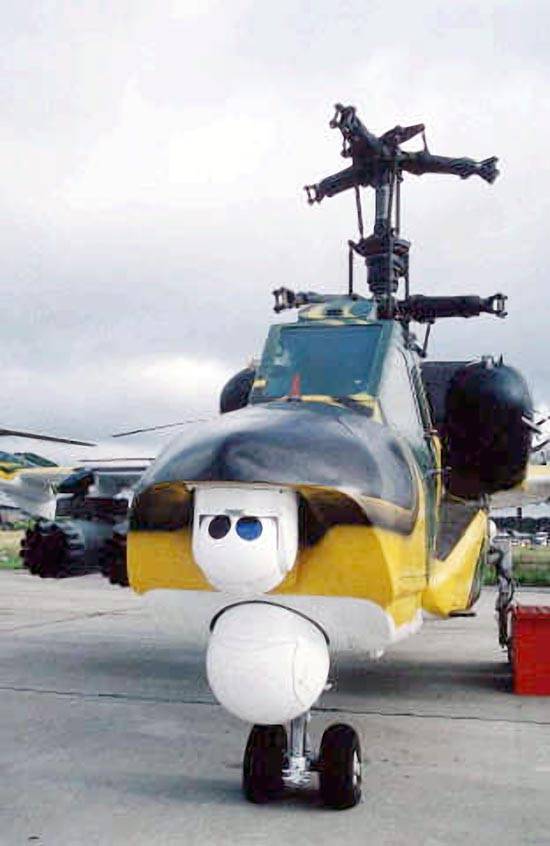
10 years after the conclusions of the State Commission, the night version of the Ka-50 was ready. It was 1997 outside. And in the United States, AN-64A Apache combat helicopters equipped with the TADS / PNVS night system have been mass-produced since 1984 ...
Out of desperation caused by the crisis and the lack of both funds and equipment, with the permission of the Government, the Kamov Design Bureau signed a contract with the French company Thomson for the supply of thermal imagers to test the inclusion of these devices in the general network of the helicopter.
Kamovtsy integrated the thermal imager "Victor" from "Thomson" into the domestic optical-electronic system "Samshit-E". The system was named Samshit-50T and made it possible to test the Ka-50N and Ka-52 for helicopter operation in combat mode at night.
The thermal imager provided detection of a tank-type target from a distance of 7 kilometers, accurate aiming could be carried out from a distance of 4,5 - 5 km.
In addition to optical-electronic means, the helicopter received the Arbalet radar station, the antenna of which was placed above the propeller column in a special fairing. "Crossbow" solves not only issues of attack, but also protection, being included in the onboard defense system, warns the pilot of a possible attack from enemy aircraft or missiles.
According to the nomenclature of weapons, the Ka-50N is identical to the "day" Ka-50. Since the designers and engineers managed to pair the Samshit-50T and the Shkval complex, it became possible to use the Whirlwind missiles both day and night.
The fate of the Ka-50N was decided by the absence of a domestic thermal imager, at least closely similar in characteristics to the French device. In 1997, the helicopter could go into production if all the necessary equipment were available. But since this did not happen, then mass production did not take place.
Ka-50SH
Another attempt to create "what we need" instead of "what we can". An attempt began in 1993, when it became clear that the Mercury television system did not live up to the hopes placed on it. The mass and dimensions of the installation did not allow placing the "night TV" on aircraft.
Therefore, the attention of designers switched to infrared vision systems, that is, thermal imagers. The experiments of the Krasnogorsk OMZ "Zenith" together with the NPO "Geophysics" and the Kazan Institute of Applied Optics did not end in anything, and as mentioned above, the Ka-50N was forced to be equipped with imported equipment.
However, specialists from the Ural Optical and Mechanical Plant in Yekaterinburg created a whole concept of systems based on the principle of line of sight stabilization using high-precision gyroscopic sensors, a ball bearing and a three-coordinate torque motor.
UOMZ engineers created a series of optoelectronic systems, collectively called GOES - gyro-stabilized optoelectronic systems. Yes, these are the very “balls” that we can observe today on many combat vehicles, inside which are placed electronic modules for various purposes: a thermal imager, a laser rangefinder-target designator, an ATGM laser guidance system, a laser irradiation direction finder, an infrared direction finder, and so on.
Based on the developments of UOMZ, the GOES "Samshit-50" was created, created specifically for the Ka-50. "Samshit-50" provided a high degree of stabilization with a single line of sight for all modules and provided a wide range of position changes, +/-235 degrees in azimuth and 160 degrees in elevation with a high angular velocity of up to 60 degrees / sec.
GOES "Samshit-50" was installed on a helicopter, which received the Ka-50Sh index. A ball with a diameter of 640 mm contained four main modules: a laser rangefinder-target designator, a television channel, a laser-beam control system for the Vikhr ATGM, and a Victor thermal imager from the French company Thomson. Domestic developments were never completed.
In addition to the Samshita modules, the Crossbow over-the-bush radar was installed. But the main difference between the Ka-50Sh "Ural assembly" from the Ka-50N was a satellite navigation system with a color LCD screen, which displayed a map with the position of the machine.
In the process of working out, "Squall" and "Samshit-50" were swapped, the GOES ball was moved down the bow, and the "Squall" window went higher. At the same time, the Ka-50Sh received a new set of on-board equipment developed by the Ramenskoye Instrument Design Bureau. Actually, we can see these three color screens today. The Thomson thermal imager was replaced. Alas, French, from the company SAGEM.
In addition, to ensure the safe piloting of the Ka-50 at night, specialists from the Kamov company, NPO Orion and Geophysics-NV proposed equipping their crews with ONV-1 night vision goggles. This made it possible to partially solve the problems of flight safety at night, especially for "day" type machines. The ONV-1 glasses were tested on the Ka-50 in 1999 and received positive feedback.
As a result, the helicopter was killed by the tactics of combat use, based on the fact that there was only one person in the crew. The Ka-50 was supposed to barrage, waiting for information to arrive on a closed TV channel from the media, then go to the strike position and engage the target, being outside the enemy’s air defense coverage or entering it for a short time.
Given that either other helicopters (Ka-60 or Ka-29) or unmanned vehicles (work was underway on the Ka-37 and Ka-137) were supposed to issue target designations, the Kamov Design Bureau eventually decided to take a cardinal step: installing information collection modules to the helicopter with the introduction of the second crew member.
So the Ka-52 appeared, and the Ka-50 finally went down in history. To date, out of 16 aircraft produced, 4 are in airworthy condition and are used as training aircraft. There is no talk of producing a single-seat attack helicopter Ka-50. Production was officially discontinued in 2009.
Ka-52 "Alligator"
Actually, in fact, what they left, they came to: a two-seat attack helicopter capable of operating completely independently of the centers for issuing instructions.
In general, the Ka-52 was originally, work on a two-seater machine began in 1984, and initially such a helicopter was planned as a reconnaissance vehicle, which would issue target designations for the Ka-50. The program was slowed down (if not stopped) by the collapse of the entire Soviet system in the 90s, but it was not abandoned in the Kamov Design Bureau.
General Designer Mikheev decided to transfer the reconnaissance and target designation complex to the Ka-50, which, in theory, had already been put into production. Naturally, this required a second crew member to be placed in the cockpit, who was supposed to work with a complex of reconnaissance radar equipment and an optical-electronic surveillance complex. It is clear that it was unrealistic to assign so many duties to the pilot.
At the same time, the idea of placing the pilot and operator side by side, and not one behind the other, as on classic machines, was implemented. Such an innovative placement (as on the Su-34) greatly facilitated the interaction of pilots, especially on difficult flights at low altitudes. In addition, this made it possible not to duplicate instruments and displays for outputting operational information.
In 1994, the shock-reconnaissance version was ready, but the cockpit came out wide, angular and too noticeable in the radio range. Perhaps it was the desire to make the most of the ready-made elements from the Ka-50, but everything had to be redone. The work took almost two years, the glazing scheme had to be redone almost completely, plus the placement of the second ejection cross forced me to work with the weight distribution of the car.
The result was a completely different helicopter, but 86% unified with the Ka-50, for which there were no questions in terms of components and components. Where the proper name, "Alligator" came from, there is no information, but the helicopter was dubbed that way.
The main difference between the "Alligator" and the "Black Shark" is the bow. Double cabin with a new electronic "stuffing", which replaced the electromechanical devices of the last century. And a slightly larger mass. Otherwise, the Ka-52 is still the same Ka-50, the assortment of weapons from the Ka-50Sh has been retained.
Flight performance, of course, deteriorated. The helicopter has become heavier by more than half a ton, this was expected initially and there is no secret about that. It was planned to neutralize this by installing more powerful TVZ-117VMA-SBZ engines from Motor Sich, but in the end they left the Klimov VK-2500.
In general, fine-tuning the Ka-52 to the ideal took a very long time, until 2006. But it was worth it, because even the heavier helicopter performs all the same aerobatic maneuvers as the Ka-50.
In 2008, serial production of the helicopter began.
It is worth mentioning separately about the "stuffing". Naturally, thirty years have not been in vain, even more so, if you look at the general level, today the Ka-52 is at a higher level than the Ka-50 at one time.
Even despite the fact that electronics in our country has never been something ultra-modern (which proves the use of thermal imagers for 20 years), the Ka-52 looks quite modern.
The avionics-52 complex, also known as Argument-2000, is a completely modern complex that provides the solution of all flight and navigation tasks in all weather conditions and at any time of the day.
Argument-2000 includes the Baget-53 data processing center, the PNK-37DM, TOES-520 flight and navigation kit, the all-round surveillance and flight system, the defense complex, the airborne communications system, the new RN01 Arbalet-52 radar ".
"Crossbow-52" became a two-channel radar. The first part is located in the bow and provides the crew with flight at ultra-low altitudes and search for targets with subsequent aiming. The second channel with over-hub antenna provides all-round visibility and provides anti-missile protection.
All data received from the radar and TPP are combined into a single stream and broadcast by Argument to LCD screens in the cockpit.
The armament is practically the same as that of the Ka-50, but there are six hardpoints instead of four. The main weapons are the same laser-guided Ataka missiles, 9M120-1 with a tandem cumulative warhead against armored vehicles and 9M120F-1 high-explosive with a volumetric detonating mixture against personnel. Igla-V missiles can be used against air targets.
There is a certain potential for strengthening weapons. The bet is on the new Hermes-A missiles, the range of which is expected to be 15-20 km, which will allow the helicopter to attack a target outside the coverage area of its worst enemy - short-range air defense. Ka-52 will be able to take 16 of these missiles.
As the weapons short-range adaptation is considered for aircraft carriers of ATGM "Chrysanthemum" induced by radio channel. Ka-52 will be able to take on board 16 missiles. The classic Ataka missiles, which are also undergoing modernization stages, should not be discounted.
LTH Ka-52
The diameter of the rotor, m: 14,50
Wingspan, m: 7,30
Fuselage length, m: 13,80
Height, m: 4,90
Weight, kg
- empty: 7 800
- normal takeoff: 10 400
- maximum take-off: 11 300
Engine: 2 x GTE Klimov VK-2500 x 2400 hp
Maximum speed km / h: 310
Cruising speed, km / h: 250
Ferry range, km: 1
Practical range, km: 455
Rate of climb, m / min: 960
Practical ceiling, m: 5 500
Static ceiling, m: 3
Crew, prs: 2
Armament:
- one 30 mm 2A42 cannon with 460 rounds
combat load - 2000 kg on 6 suspension units
- 4 x 3 Shturm-VU ATGMs and 2 x 2 Igla-V air-to-air missiles or 80 80-mm NUR or 10 122-mm NUR
FAB-100, FAB-500, KMGU-2; ZB-500; RBC-500, RBC-250, PTB 4 x 550 liters or cannon containers UPK-23-250.
Forty years of evolution have not been wasted. On the one hand, over these forty years less than two hundred combat vehicles were produced, but the initially laid down potential will definitely allow the Ka-52 to serve for a very long time. And, to serve with benefit.
The Mi-24, which recently celebrated its anniversary, was produced in the amount of more than three thousand copies, is still fighting and doing it effectively. But new helicopters like Ka-52 and Mi-28N will still take their toll. Not much younger in age, but more modern, these machines can be relevant for several more decades. So, as practice has shown, forty years - this can only be the beginning of an even longer and more impressive journey that is in store for this combat vehicle.
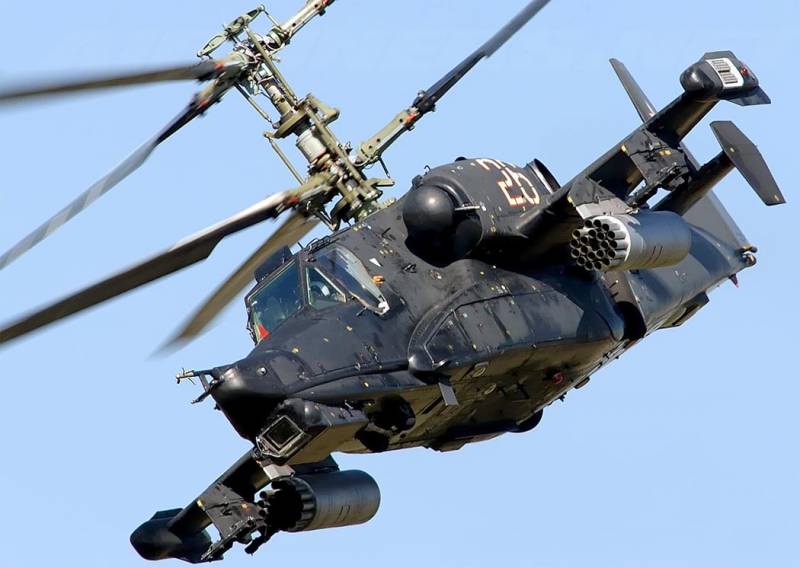
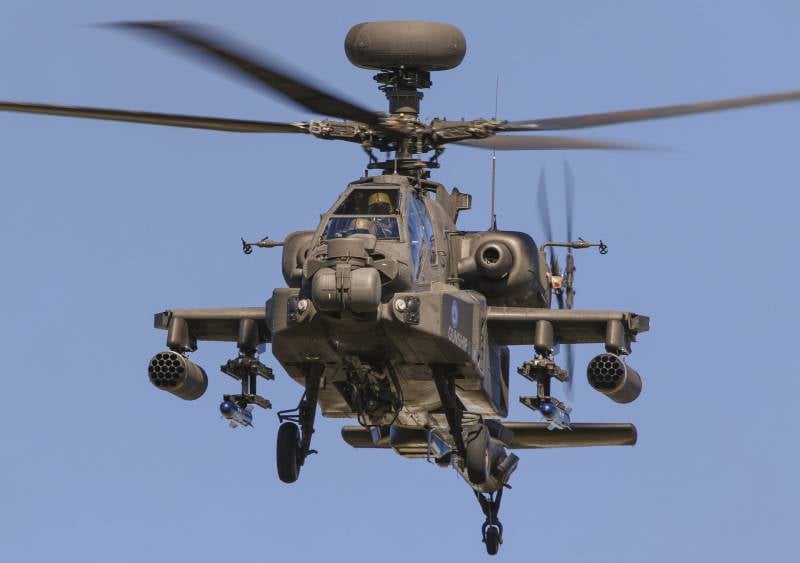
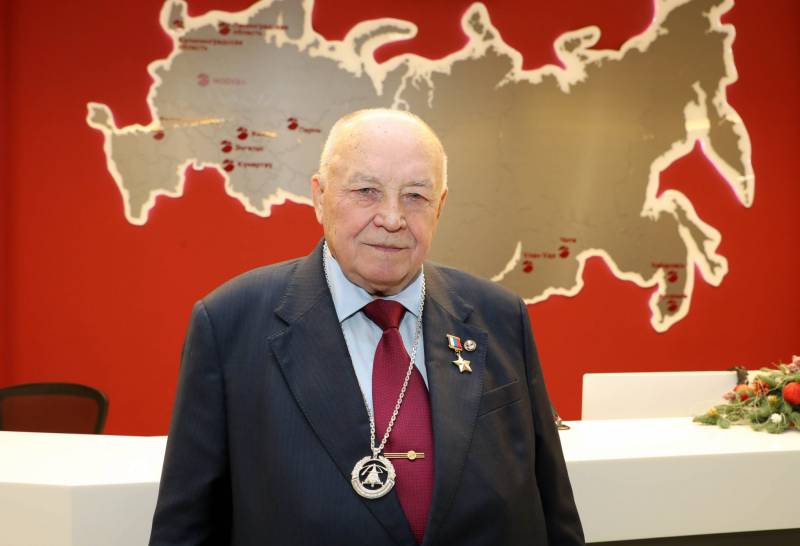
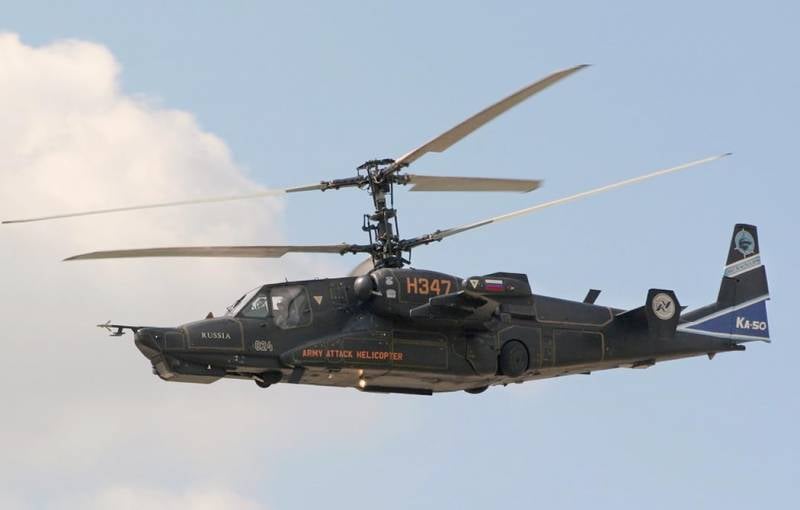
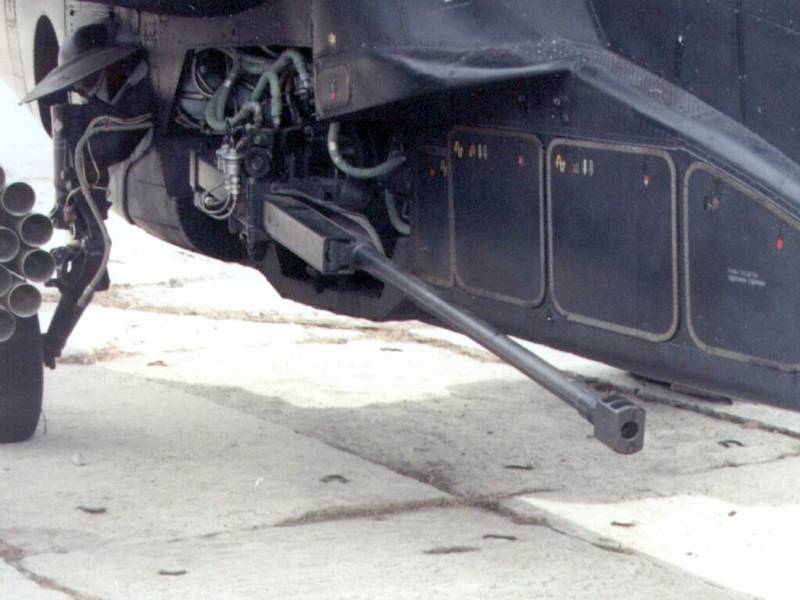
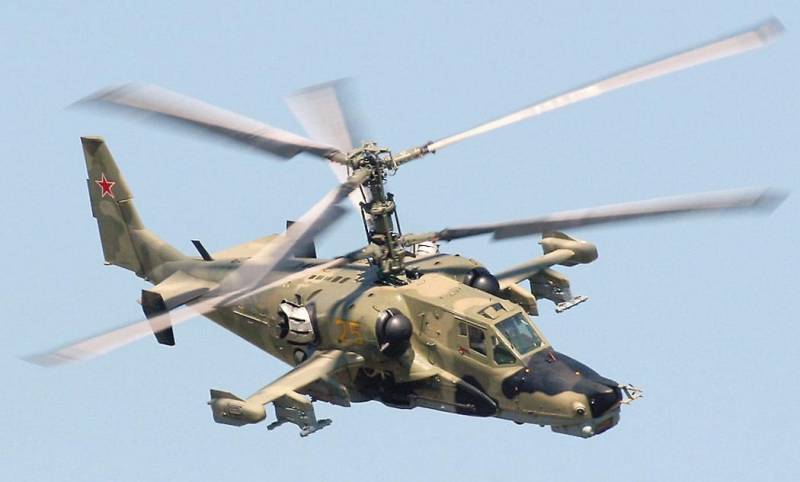
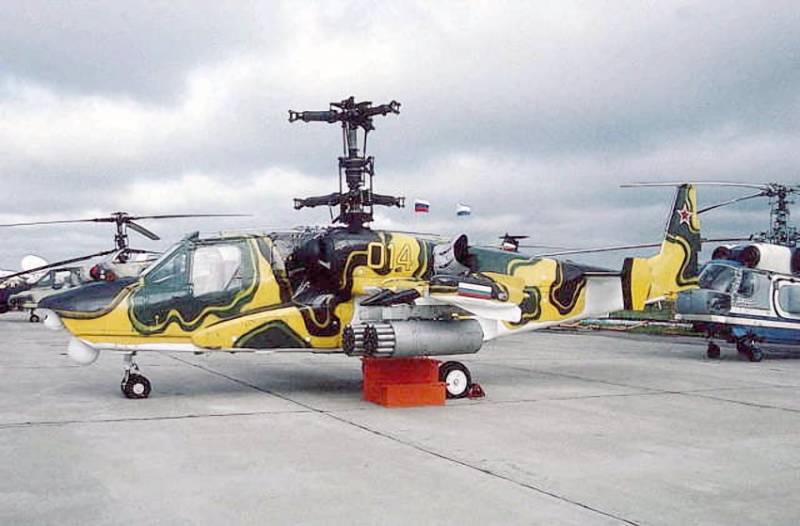
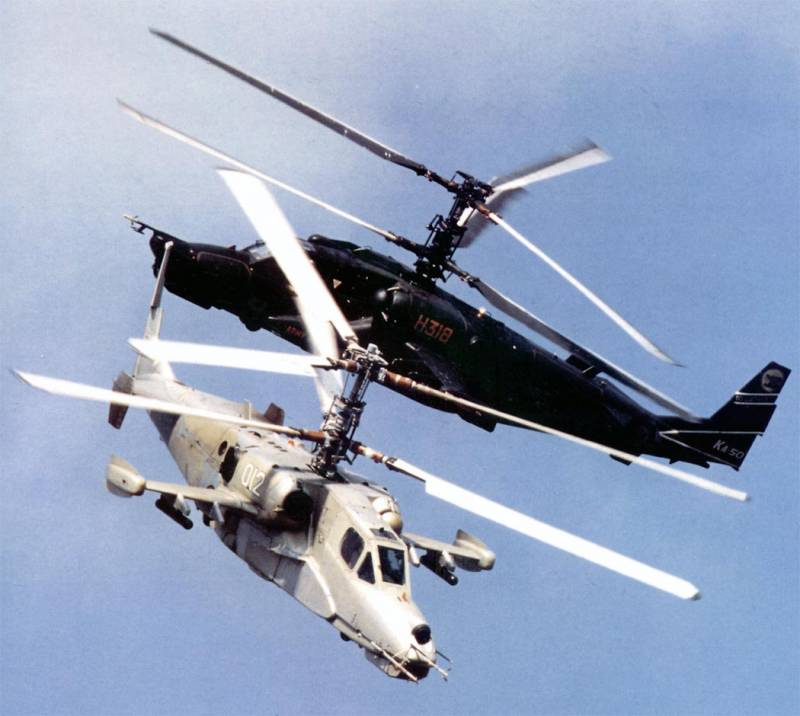
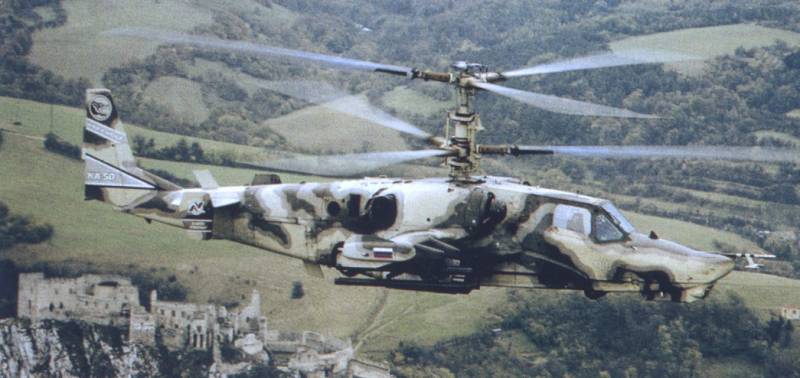
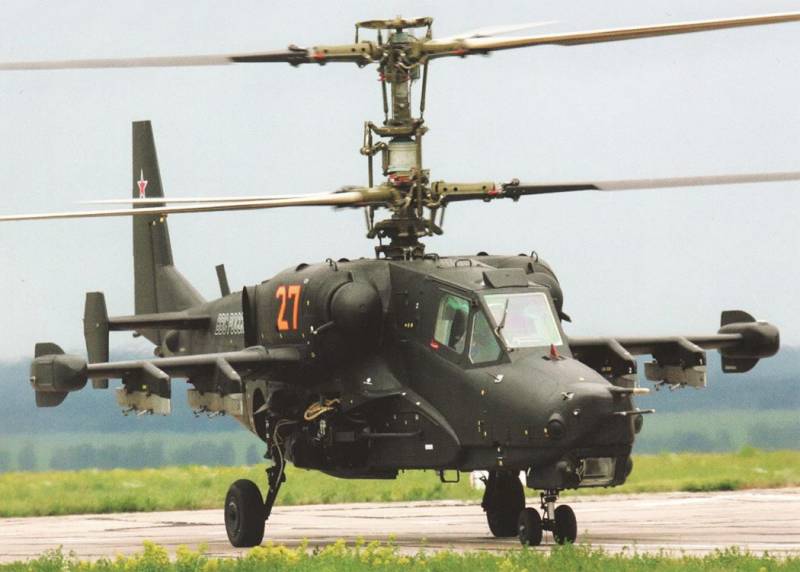
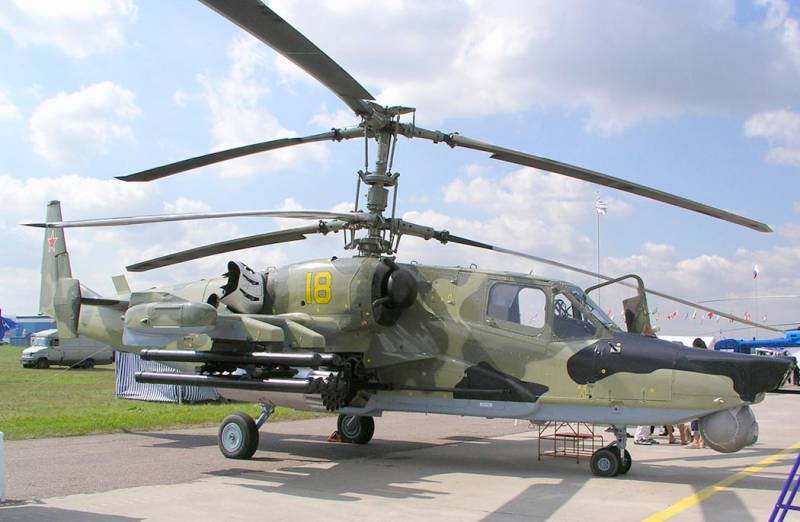
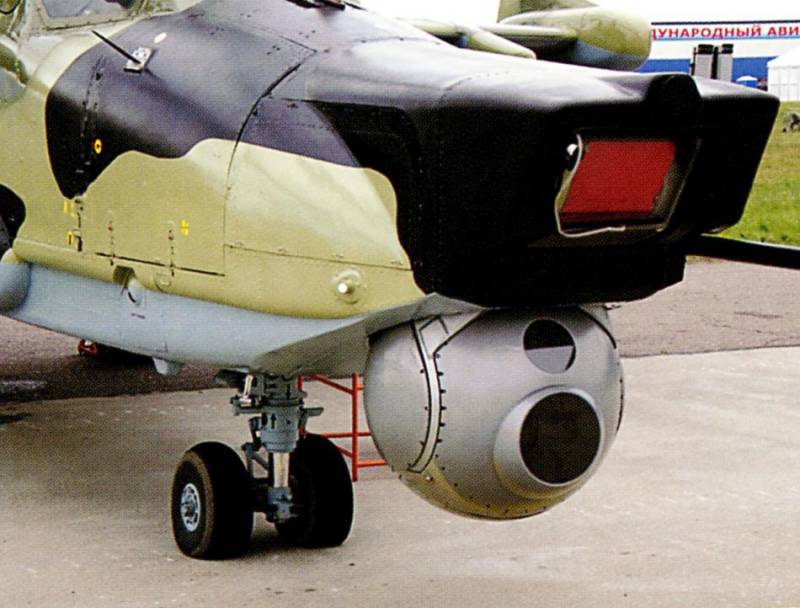
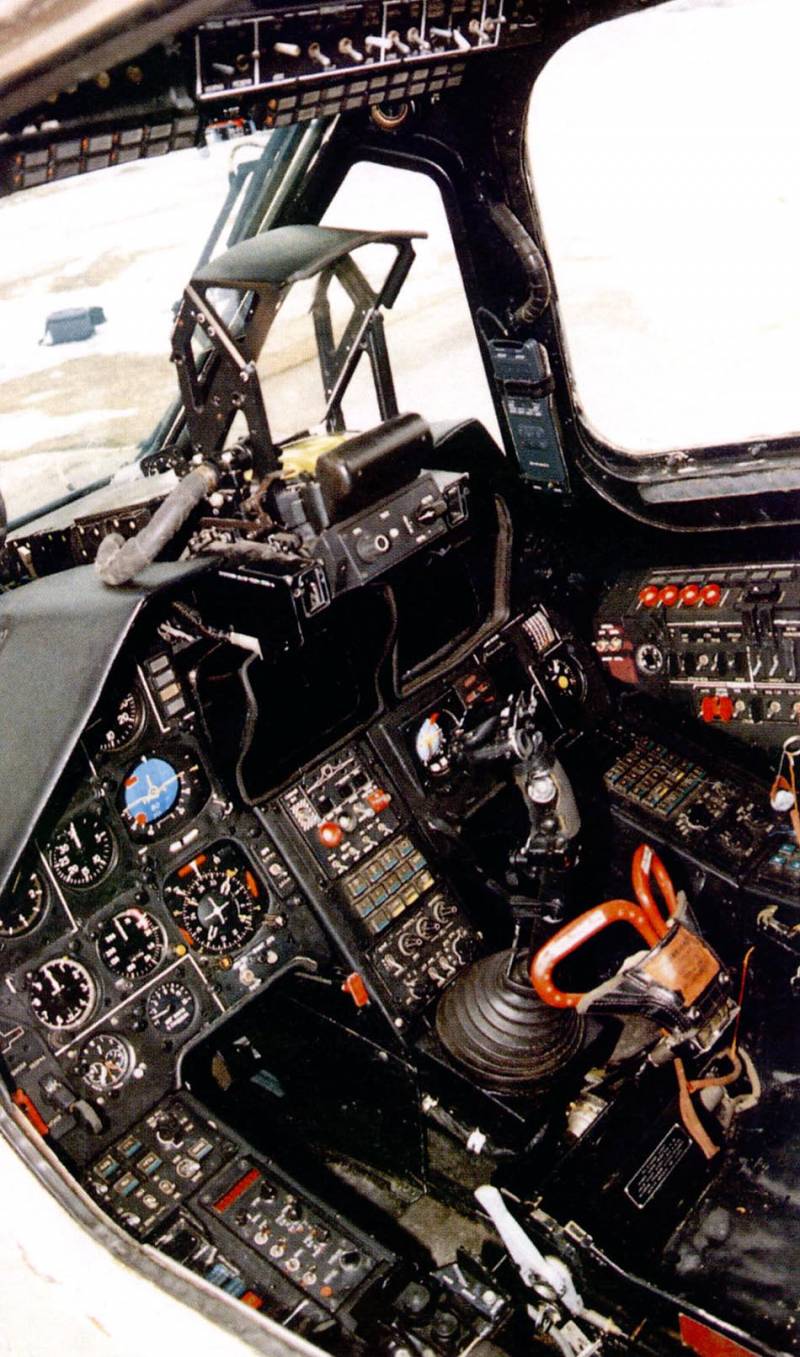
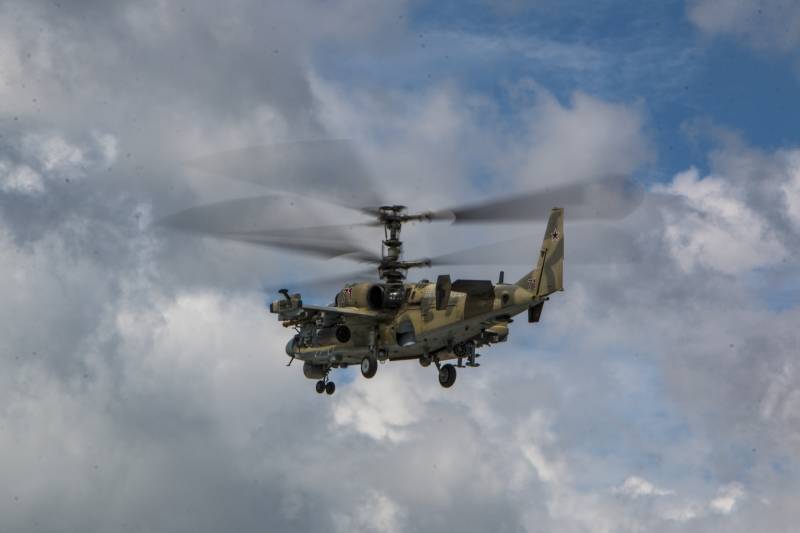
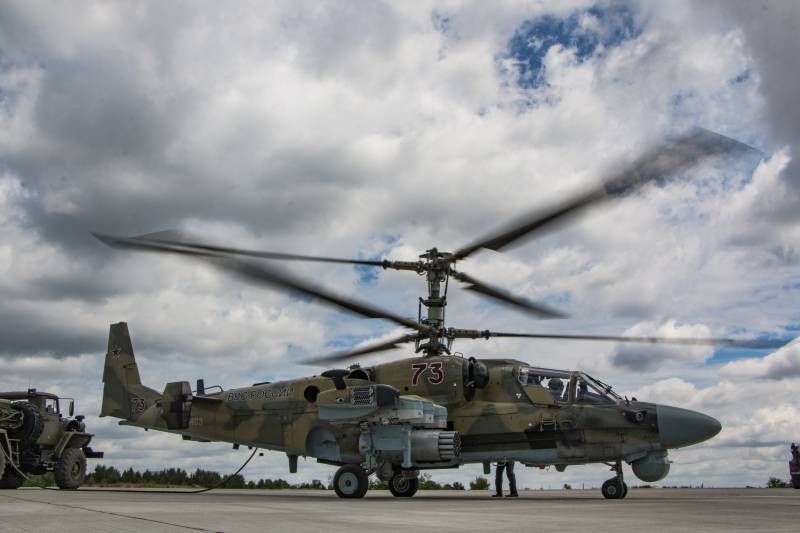
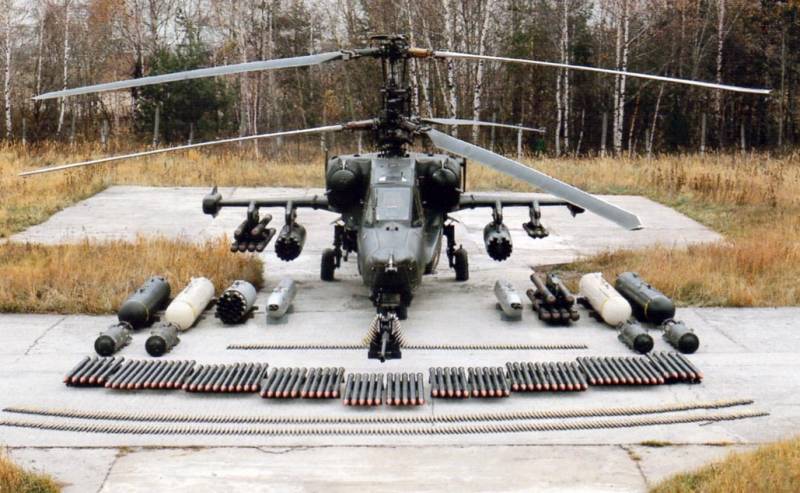
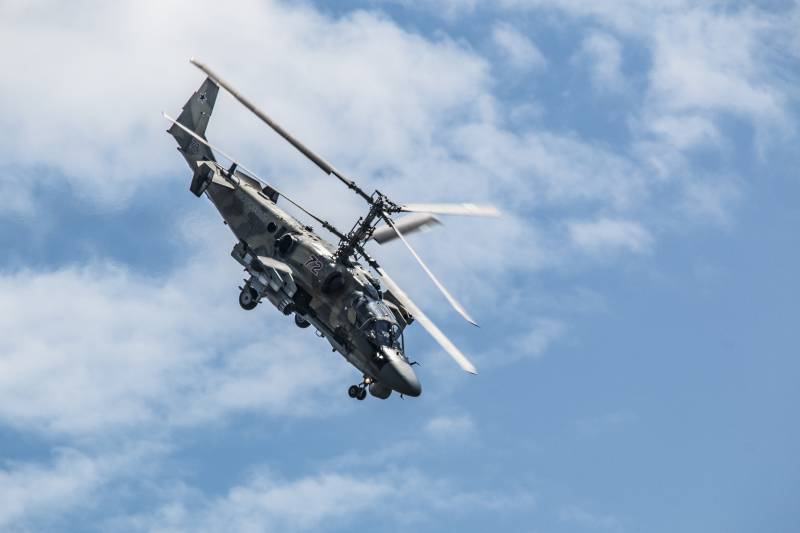
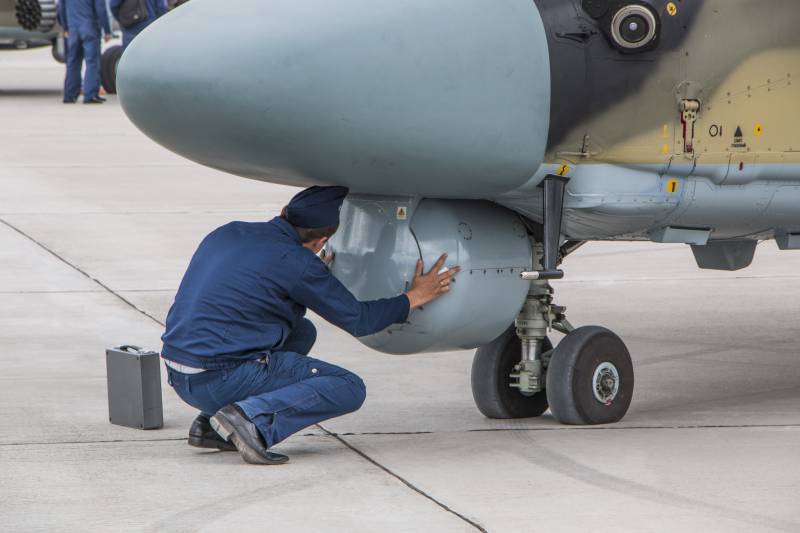
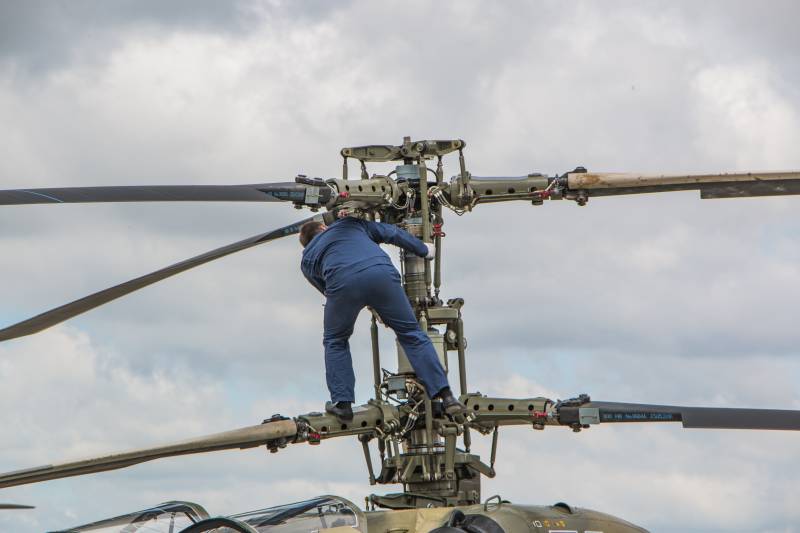
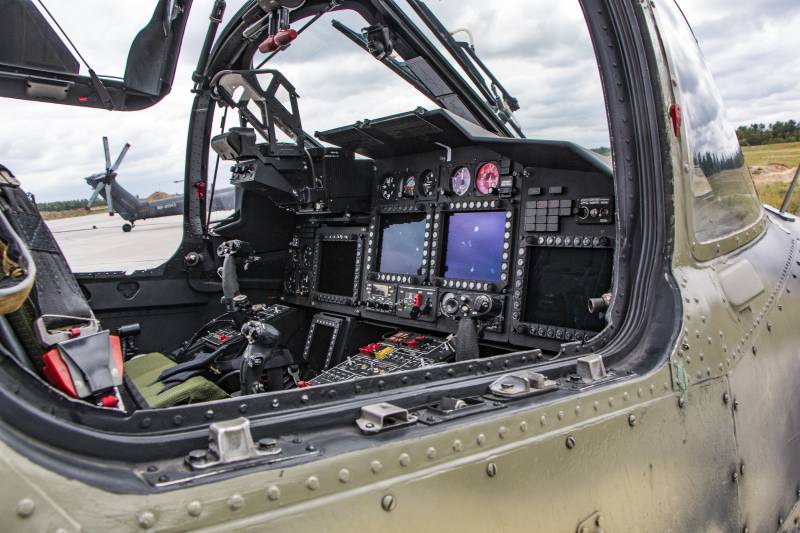
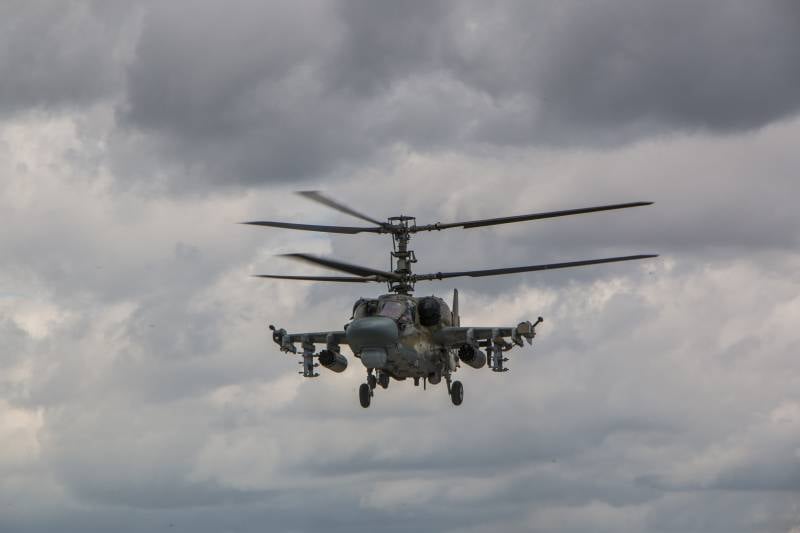
Information